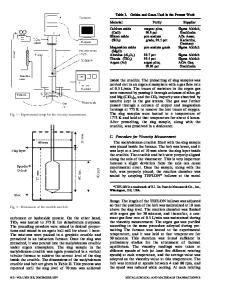Study of Tb-doped Li 2 O-LaF 3 -Al 2 O 3 -SiO 2 Glasses Containing Silver Nanoparticles
- PDF / 92,092 Bytes
- 6 Pages / 612 x 792 pts (letter) Page_size
- 81 Downloads / 307 Views
1208-O09-16
Study of Tb-doped Li2O-LaF3-Al2O3-SiO2 Glasses Containing Silver Nanoparticles Z. Pan*, A. Crosby, O. Obadina, A. Ueda, R. Aga Jr, R. Mu, and S. H. Morgan Department of Physics, Fisk University, Nashville, TN 37208, U.S.A.
ABSTRACT Tb-doped Li2O-LaF3-Al2O3-SiO2 (LLAS) glasses containing silver were fabricated using melt-quenching technique. Silver nanoparticles (NPs) in glass matrix were confirmed by optical absorption and X-ray diffraction (XRD). The nucleation of silver NPs was controlled by heattreatment. A broad absorption band peaked at about 420 nm was observed due to surface plasmon resonance (SPR) of the silver NPs. This SPR absorption of silver NPs increases with the time of heat-treatment. Photoluminescence (PL) emission and excitation spectra were measured on Tb-doped LLAS glasses with and without silver NPs. Strong Tb3+ luminescence was observed. For excitation at 325 nm, luminescence of Tb3+ ions increases for the glass containing silver NPs compared to that in the glass without silver NPs. After further heat-treatment at 520 ºC for 5 hours, Tb3+ luminescence decreased. Our luminescence results suggest that there are two competitive effects, enhancement and quenching effects, acting on Tb3+ luminescence in the glass containing silver NPs. The enhancement of Tb3+ luminescence is attributed to local field effects due to the excitation of SPR of silver NPs. The quenching effect in the presence of Ag NPs suggests an energy transfer from Tb3+ ions to silver NPs exists, which may provide an additional non-radiative relaxation pathway for the excited Tb3+ ions. INTRODUCTION Rare-earth doped glasses are important for applications in optical devices such as scintillator, optical fiber amplifiers, lasers, and optical converters of infrared radiation to visible regions, etc [1-4]. In addition to the common advantages of low-cost, large-volume production possibility and easy shaping of elements of glasses, oxide glasses generally possesses good mechanical strength, chemical durability, and thermal stability. The Tb-doped Li2O-LaF3-Al2O3-SiO2 (LLAS) glasses were previously reported to have good photoluminescence (PL) and β-induced luminescence light-yield for scintillator application [1]. The incorporation of metallic nanoparticles (NPs) in rare-earth doped glasses may enhance or quenching the luminescence of rare-earth ions [5, 6]. The enhancement has been attributed to local field enhancement effects on absorption and emission of rare-earth ions or energy transfer from metallic NPs to rare earth ions due to the excitation of SPR of metallic NPs [7]. The quenching effect is due to energy transfer from ions to the metallic NPs [5, 6]. The rare-earth doped glasses containing metallic NPs have been attracted great interest recently [7 -9]. However, the conditions of energy transfer from metallic NPs to rare earth ions have not been clarified [5, 6]. With the object to further understand the interaction between metallic NPs and rare earth ions in glass, we have studied Tb-doped LLAS glass containing silve
Data Loading...











